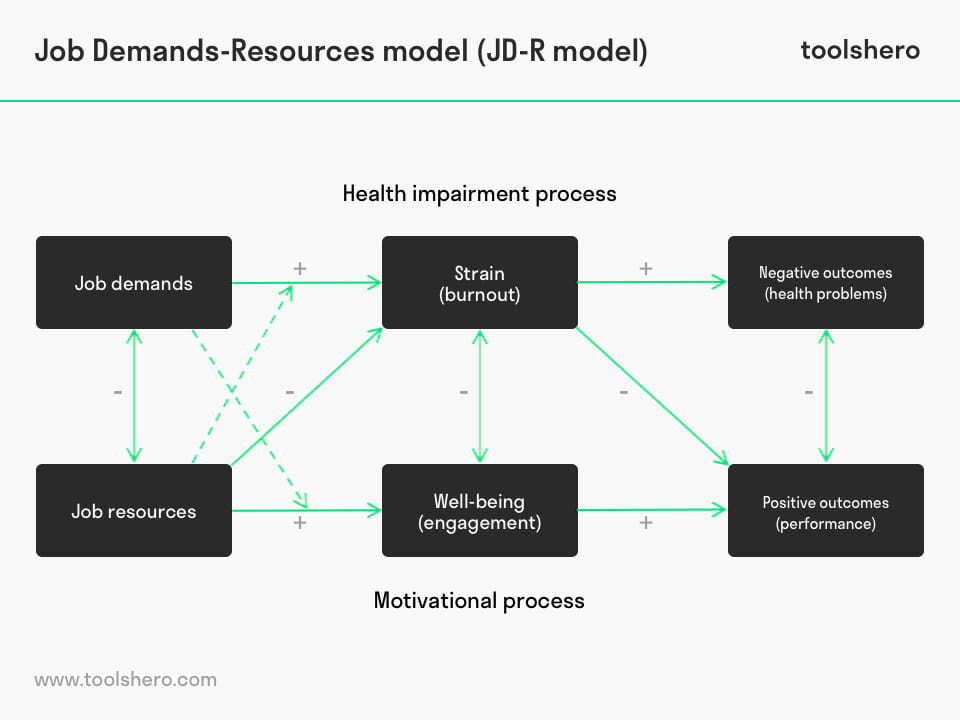Job Demands Resources Model

Job Demands Resources Model: this article provides a practical explanation of the Job Demands-Resources Model or JD-R model for work engagement. After reading, you’ll have a basic understanding of this powerful management tool.
What is the Job Demands-Resources Model
The Job Demands-Resources Model, or JD-R model, is a model that encourages the functioning of employee well-being. It is used by managers and supervisors to manage employees’ involvement. The work stress model suggests that stress arises from the imbalance between the requirements of the job and the resources the employee has available to meet those requirements.
The model divides the working conditions into two components: job requirements and job resources. Furthermore, the model shows that when the job resources are scarce and job requirements are high, factors such as stress and the chance of a burn-out increase. If the job resources are sufficiently available and the job requirements are high, the right factors, such as involvement and performance levels, are improved.
The Job Demands-Resources Model (JD-R model) was introduced in 2006 as an alternative to the already existing models for employee well-being. The authors of the Job Demands-Resources Model are Eva Demerouti & Arnold Bakker.
They published the results of a long-term study in The Journal of Managerial Psychology.
Job Demands Resources Model Components
The study prior to the creation of this JD-R model delivered proof for the existence of these two simultaneously occurring processes. A complex job demands a lot of mental and physical capacities of employees. This can lead to energy depletion and health problems.
However, when the job resources don’t form an obstacle, these could improve the involvement of employees and the performance of the organisation as a whole. This is generally true for people with a high position. For people with a lower position, the availability of job resources doesn’t necessarily create extra motivation.
Job Requirements
Job requirements concern the physical, social or emotional characteristics of the job and the work environment. This mainly concerns factors such as time pressure, work pressure, relationships, stressful environments and leadership. These often demand long-term physical and/or psychological effort and skills.
Job Resources
The job resources, also called positives, are the physical, organisational or social factors that help the employee to achieve the established objectives and reduce stress. All resources that are used to reduce the job requirements fall under the job resources. Examples of these are: coaching, career development opportunities, good relationships, autonomy, and more.
Balance
The balance between the job resources in de JD-R Model and the job requirements determines the degree to which employees feel energised by their job. If the balance is negative, and the work demands more in terms of energy than it yields, this leads to a burnout or physical symptoms. The balance is positive when the job yields more energy than it costs. This leads to an engagement visible in the attitude and behaviour of employees. Usually, they display characteristics such as involvement, loyalty, goal-orientation and often take initiative. They always put in 200 per cent and therefore perform well at work. In case of imbalance, however, the employees are exhausted and feel burned out.
Positive Outcomes
- The employee is more productive
- There is little absence
- The working atmosphere is pleasant
Negative Outcomes
- Relatively unproductive
- Lack of focus
- More mistakes
- Negative working atmosphere
- More absence
Job Demands-Resources Model : The Role of Involved Employees
Both employee satisfaction and employee involvement play a central role in the Job Demands-Resources Model (JD-R Model). Employee satisfaction indicates how happy or satisfied the employees are. Satisfied employees more often have a good balance between job resources and job requirements. A satisfied employee is also generally more involved. And involved employees create value for the organisation.
Employee involvement exceeds simply attending events or carrying out activities. Involved employees look at the big picture, understand the organisational objectives, and their role. This leads to better decision making, which is essential in gaining a larger market share.
Managing Employee Involvement
As a manager, it can be challenging to keep your employees sufficiently motivated and involved. Yet, throughout the years, many studies have been conducted into employee satisfaction and how managers can actively encourage this. Several tips for encouraging involvement are:
- Achieve and celebrate results
- Create new strategies
- Make the jobs attractive
- Create connectedness
- Be an authentic leader
- Acknowledge employees in the presence of others
- Be fully involved with the employees
- Identify yourself with the organisation
Job Demands-Resources Model : Step-by-step Plan to Determine Your Personal Balance
The Job Demands-Resources Model (JD-R Model) is easy to apply and can be used for each position. Use the step-by-step plan below to determine your work balance.
Consult the article about Robert Karasek’s Job Demand Control Model for further information on work balance.
1. Identify job requirements
Start by making a list of all job requirements of the position. Job requirements include all physical, psychological, social or organisational aspects of a job. Examples of these are:
- High work pressure
- Time pressure
- Availability
- Work speed
- Effort
- Complexity
- Energy use
- Unpleasant work environment
- Poor work relationships
- Unclear objectives
- Bureaucratic inefficiencies
- Emotionally draining activities
- Limited opportunities for career growth
2. Identify job resources
The list of job requirements might look negative, but doesn’t necessarily have to be so. The list includes examples and the job requirements differ per job. When the right resources are available, this might even create extra motivation. Note down all job resources to compare these to the job requirements in the next step.
- Opportunities for career growth
- Personal development opportunities
- Autonomy
- Coaching
- Clarity regarding positions
- Pleasant work environment
- Good work relationships
3. Determine the balance
The exact costs and benefits are different for everyone. Think about whether your job demands more energy than it yields.
4. Be proactive in restoring the balance
In case of an imbalance between requirements and resources, actively look for ways to restore the job resources. Many of these matters can be changed without this costing too much money. One way to find out what could be improved on the work floor is to speak with co-workers. If you agree on certain matters, discuss it with management or the supervisor.
Job Demands-Resources Model (JD-R Model) Summary
The Job Demands-Resources Model (JD-R Model), is a model that studies the functioning of employees’ well-being.
The model consists of two main elements: job requirements and job resources. Job requirements concern the physical, social or emotional characteristics of the job and the work environment. The job resources encompass organisational or social factors that could help the employee to strive for objectives.
The balance between these two factors is very telling about the experienced stress levels and the well-being of the employees. Positive outcomes include: higher productivity, little absence and good work relationships. Negative outcomes: lack of focus, more mistakes and more absence.
The Job Demands-Resources Model (JD-R Model) can be used by everyone with a job to determine the balance.
For this purpose, the user must create a list of the job requirements, and compare this to the list of job resources and positives.
In case of an imbalance, job resources must be pro-actively be promoted. Making sure an employee is involved doesn’t just benefit the employee’s well-being, it also benefits the entire organisation through the extra value he offers.
Now It’s Your Turn
What do you think? Are you familiar with the explanation of the Job Demands-Resources Model (JD-R Model)? Have you already used the step-by-step plan in this article to determine your own balance? Which other models on employee well-being do you know? Do you have any tips or additional comments?
Share your experience and knowledge in the comments box below.
More information
- Bakker, A. B., Demerouti, E., & Verbeke, W. (2004). Using the job demands‐resources model to predict burnout and performance. Human Resource Management: Published in Cooperation with the School of Business Administration, The University of Michigan and in alliance with the Society of Human Resources Management, 43(1), 83-104.
- Bakker, A. B., & Demerouti, E. (2007). The job demands-resources model: State of the art. Journal of managerial psychology, 22(3), 309-328.
- Demerouti, E., Bakker, A. B., Nachreiner, F., & Schaufeli, W. B. (2001). The job demands-resources model of burnout. Journal of Applied psychology, 86(3), 499.
- Demerouti, E., & Bakker, A. B. (2011). The job demands-resources model: Challenges for future research. SA Journal of Industrial Psychology, 37(2), 01-09.
- Xanthopoulou, D., Bakker, A. B., Demerouti, E., & Schaufeli, W. B. (2007). The role of personal resources in the job demands-resources model. International journal of stress management, 14(2), 121.
How to cite this article:
Janse, B. (2019). Job Demands-Resources Model. Retrieved [insert date] from toolshero: https://www.toolshero.com/human-resources/job-demands-resources-model/
Add a link to this page on your website:
<a href=”https://www.toolshero.com/human-resources/job-demands-resources-model/”>toolshero: Job Demands-Resources Model</a>
Published on: 15/07/2019 | Last update: 10/02/2022













